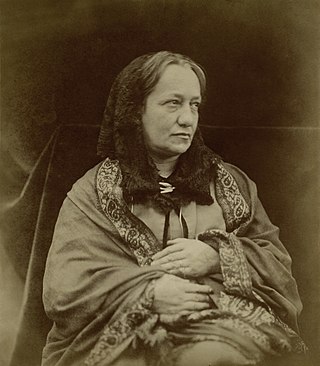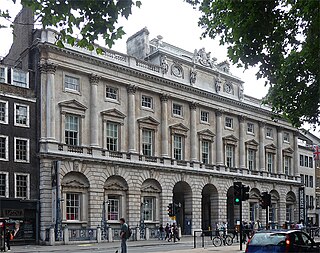Related Research Articles

Julia Margaret Cameron was a British photographer who is considered one of the most important portraitists of the 19th century. She is known for her soft-focus close-ups of famous Victorians and for illustrative images depicting characters from mythology, Christianity, and literature.

The Courtauld Institute of Art, commonly referred to as the Courtauld, is a self-governing college of the University of London specialising in the study of the history of art and conservation. It is among the most prestigious specialist colleges for the study of the history of art in the world and is known for the disproportionate number of directors of major museums drawn from its small body of alumni.

George Washington Wilson was a pioneering Scottish photographer. In 1849, he began a career as a portrait miniaturist, switching to portrait photography in 1852. He received a contract to photograph the Royal Family, working for Queen Victoria and Prince Albert. He pioneered various techniques for outdoor photography and the mass production of photographic prints as he gradually began to largely do landscape photography in the 1860s. By 1864 he claimed to have sold over half a million copies.

Henry Peach Robinson was an English pictorialist photographer best known for his pioneering combination printing - joining multiple negatives or prints to form a single image; an early example of photomontage. He joined vigorously in contemporary debates in the photographic press and associations about the legitimacy of 'art photography' and in particular the combining of separate images into one.

Terence Patrick O'Neill was a British photographer, known for documenting the fashions, styles, and celebrities of the 1960s. O'Neill's photographs capture his subjects candidly or in unconventional settings.

Antonio Beato, also known as Antoine Beato, was an Italian-British photographer. He is noted for his genre works, portraits, views of the architecture and landscapes of Egypt and other locations in the Mediterranean region. He was the younger brother of photographer Felice Beato (1832–1909), with whom he sometimes worked. Antonio and his brother were part of a small group of commercial photographers who were the first to produce images of the Orient on a large scale.
N.A. Tombazi was a Greek photographer who, on a British Geological Expedition in 1925, apparently sighted a Yeti creature at 15,000 feet in the Himalayas of Tibet.

Helmut Erich Robert Kuno Gernsheim was a historian of photography, a collector and a photographer.

Thomas Annan (1829–1887) was a Scottish photographer, notable for being the first to record the bad housing conditions of the poor.
Shirley Baker was a British photographer, best known for her street photography and street portraits in working class areas of Greater Manchester. She worked as a freelance writer and photographer on various magazines, books and newspapers, and as a lecturer on photography. Most of her photography was made for her personal interest but she undertook occasional commissions.
Bedford Lemere & Co was a firm of British architectural photographers active in the late nineteenth and early twentieth century. It was founded by Bedford Lemere (1839-1911) in 1861, with his son Henry (Harry) Bedford Lemere (1865–1944) joining the firm in 1881.
Walter Benington (1872–1936) was a British photographer. Working in the Victorian era and the first half of the twentieth century, his important contribution to early twentieth century photography has been more fully recognised in the doctoral thesis of Robert Crow.

James Austin is an Australian fine-art and architectural photographer.
Anthony Frank Kersting was a British architectural photographer. His images of British, European, and Middle Eastern architecture also feature urban and village life, landscape, commerce, transport and leisure. He was considered to be the leading architectural photographer of his generation.
Cornelius Jabez Hughes was a British photographer, daguerreotypist, and writer. He was one of the best known portrait photographers in Victorian England, and today his photographs are included in a number of notable museum collections including the National Portrait Gallery in London and The J. Paul Getty Museum in Los Angeles.
Paul Laib was a naturalised British subject who worked as a fine art photographer in his residence at 3 Thistle Grove, Drayton Gardens, South Kensington, London.
Walton Adams (1842–1934) also known as, Arthur Walton Adams or Arthur Walter Adams, was a professional photographer working at the time when the science and art of photography was developing new techniques in Victorian Britain's "Golden Years". He took photographs of royal family members and politicians.
Otto Fein (1906–1966) was a bookbinder and photographer who worked at the Kulturwissenschaftliche Bibliothek Warburg in Germany and later in the United Kingdom after the original library migrated to London in 1933. Fein sometimes used the name Hugo Otto Fein, for example in publications in which his images featured, such as the Warburg Institute Publications. He died in 1966; his death was registered in Havering, London.
Julia Hedgecoe is a photographer known for her portraiture and architectural images. Her work also includes images of interiors, food and Spanish landscapes.
James Allan Johnstone Cash, F.R.P.S, F.I.B.P
References
- ↑ Kelly's Directory of Chemists and Druggists ...: In England & Scotland & Wales, the Channel Islands and Isle of Man. 1921.
- ↑ "History | AC Cooper". www.accooper.com. Retrieved 17 July 2020.
- 1 2 "A.C. Cooper (Colour) Ltd | Royal Warrant Holders Association". www.royalwarrant.org. Retrieved 17 July 2020.
- ↑ Price, Harry (23 March 2011). The End of Borley Rectory. Read Books Ltd. ISBN 978-1-4465-4547-8.
- ↑ Graham-Dixon, Andrew (1999). A History of British Art. University of California Press. ISBN 978-0-520-22376-9.
- ↑ "A.C. Cooper (British, active 20th century) (Getty Museum)". The J. Paul Getty in Los Angeles. Retrieved 17 July 2020.
- ↑ "Trove". trove.nla.gov.au. Retrieved 17 July 2020.
- ↑ "Portraits of the Artist | William Nicholson | Artist | 1872 -1949". williamnicholson. Retrieved 17 July 2020.
- 1 2 "Augustus Charles Cooper - National Portrait Gallery". www.npg.org.uk. Retrieved 17 July 2020.
- ↑ "Who made the Conway Library?". Digital Media. 30 June 2020. Archived from the original on 3 July 2020. Retrieved 17 July 2020.